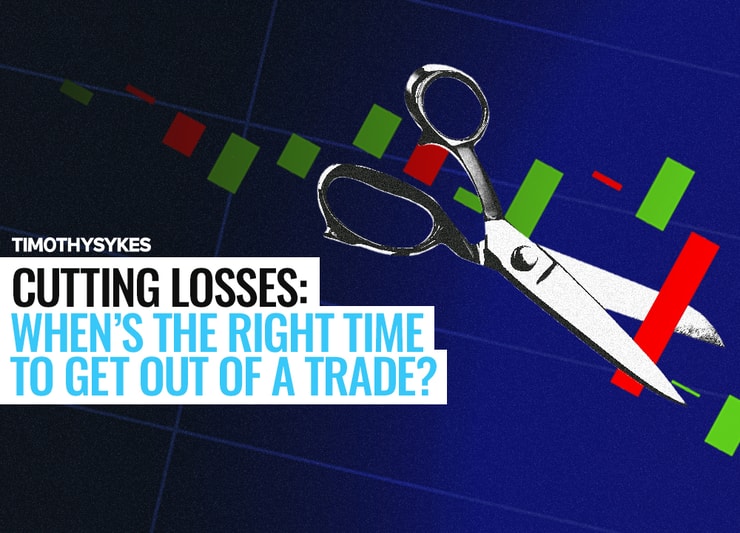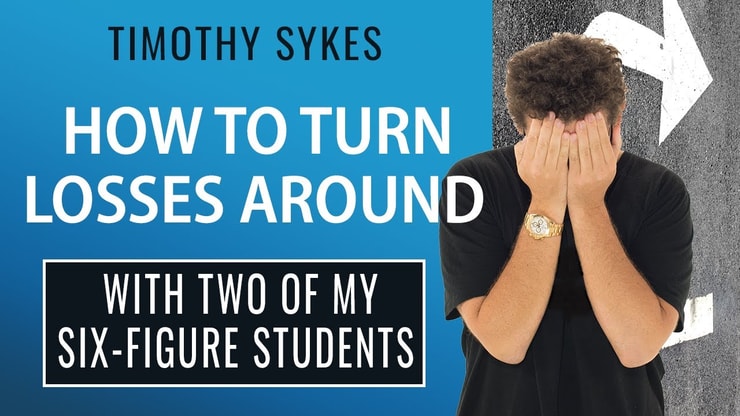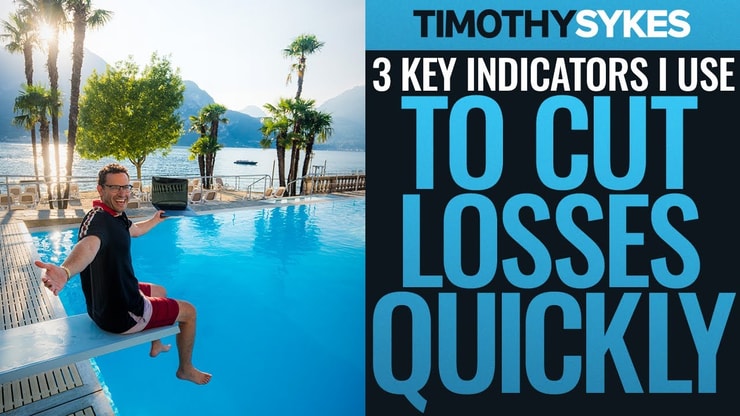Cutting losses quickly. It seems obvious, but too many traders fail when it comes to my number one rule. Let’s get one thing out of the way in case it’s not clear…
Rule #1 is to cut losses quickly.
Trading losses can add up FAST. And if you’re not careful, you can end up with the 90% of traders who lose.
So if you’re losing a lot in the stock market, you have to ask yourself why. Don’t beat yourself up about it. Every trader loses. No trader has a 100% win rate.
It’s how you lose that matters.
Which brings me to this question: When’s the right time for cutting losses and getting out of trades?
There’s no one right answer here. What works for me or some of my top students may not work for you. It depends on a lot of factors — like your strategy and risk tolerance.
So in this post, I’ll break it down and talk about what you need to consider when it comes to cutting losses.
First, let’s talk about why cutting losses is my #1 rule…
Table of Contents
Cutting Losses Protects Your Account
There are a lot of new traders in this market. And most aren’t prepared for how fast volatile stocks can move. They’re overly optimistic about how high they can go…
But they aren’t prepared for the quick downside.
I want to help you prepare and navigate this crazy volatile market. So I just created “The Volatility Survival Guide.” It’s new and costs nothing. It has over two hours of essential content to help you survive the current market volatility.
But it’s more than that. There are so many opportunities in this volatile market. So even if you’re not ready to trade, it’s the perfect market to learn. Watch this guide to get an idea of how I think. And get an inside look at how Tim Bohen uses StocksToTrade to scan for the best opportunities. It’s a great way to prepare for future market volatility.
Back to how to protect your account and…
Prevent Trading Disasters
Cutting losses quickly is how you protect your account. It prevents small losses from turning into a large disaster … or account blow-ups. Cutting your losses quickly will keep you in the game longer.
You need to give yourself enough time in the market to learn the patterns and how these stocks move. You can’t let one loss take you out of the game forever.
Even Tim Grittani lost his first $1,500 account. If he’d started with a much larger account, it would’ve been much harder to start over. He would have been out of the game forever. And he never would have made it to now almost $11 million in profits.**
He also didn’t make any money in his first nine months. So be realistic about expectations.
I always recommend new traders start with a small account. If you think you want to start trading with $10,000, start with $5,000. If you wanna start with $5,000, start with $2,500. And never risk more than you can afford to lose.
[**These results are NOT typical. Tim Grittani has spent years developing exceptional skills and knowledge. Always remember trading is risky. Never risk more than you can afford.]
Trading is a battlefield & 90%+ of participants leave the battlefield bruised/bloody/dead & it's due to lack of training & shitty weapons…your broker, your scanning/charting/news software are your weapons/what I teach is your training…so will you be equipped for battle or no?
— Timothy Sykes (@timothysykes) April 28, 2020
Why You Need to Learn to Trade Like a Sniper

Experienced traders with larger accounts can average up or down. But if you trade with a small account, you can’t do that. You usually have one shot to get in and out.
So you have to focus on solid trading plans with entries and exits.
That means not chasing any random stock that’s spiking. It also means looking for support and breakout levels on charts. There are a lot of factors that go into every trade. And it’s not an exact science. No two trades will play out exactly the same.
If you’re under the pattern day trader (PDT) rule, scaling in and out of positions isn’t an option. You only get three day trades per week.
Once you get over the $25,000 PDT limit, you can start to scale in and out like traders with larger accounts. But that’s something you have to earn with experience.
Focus on making good trades. Focus on only the best setups. Trade like a sniper. Never add to a losing position and never hold and hope. Also know it’s OK to…
Practice Your Trading Plans
I suggest you try paper trading at first. Get a feel for how fast these stocks really move without real money on the line. It can give you a chance to practice your entries and cutting losses quickly.
StocksToTrade has a great paper trading option. You can adjust the amount in your simulated account to match your real account size. You can also adjust the commission structure to closely match a real broker. Check it out with a 14-day trial.
(Full disclosure: I helped develop the StocksToTrade platform.)
The point of paper trading is to keep it as realistic as possible. It’s one advantage of practicing with StocksToTrade. The platform matches paper trades to real fills. In other words, it’s as close to real trading as you can get.
Try to trade like you’re using real money. Of course, you won’t get the same emotions as trading with real money. But it’s a chance to try trading setups and react to quick moves in real time.
But remember, no matter how much you practice…
Losses Are a Part of Trading
No matter how much practice or experience you have, losses are part of trading. You have to mentally prepare for them. Nobody’s right 100% of the time. Even I still make mistakes. Small losses are acceptable…
But if you freeze up and don’t execute your sell, you could end up with your account tied up in a losing trade. That can affect your mindset.
Even if your whole account isn’t in that trade, holding a loser is like cancer. It spreads and affects other areas of your trading. You can start revenge trading to make up the loss. Or you might trade with a larger position to make up the loss.
That’s degenerate gambler behavior. Don’t do it.
Most penny stocks won’t go back to their highs. Cut the loss and move on. It’s better for you in the long run.
You can be stubborn and watch your losses grow … Or you can accept when you’re wrong, get out, and live to trade another day.
Understand the Different Ways to Cut Losses
So how do you know when to cut losses quickly?
Again, it’s different for every trader. It comes down to experience and discipline. You have to know yourself and what works for you. And you have to have the discipline to stick to your plan.
You have to have a trading plan that includes where or when you’ll cut losses. Here’s what cutting losses can look like…
More Breaking News
- BigBear.ai’s Journey in the Stock Market: Rising Trends and Challenges
- Top Bitcoin Stocks to Watch Under “Crypto Emperor Trump”
Cutting Losses Quickly
Cutting losses quickly is rule #1. I don’t care about anything else. I just cut losses quickly — no excuses.
If I don’t like the price action, I get out! For me, it doesn’t matter where the stock is on the chart.
Sometimes I don’t even give the stock a chance to go against me. I’d rather take a small gain than a loss. Yeah, I might miss out on a better move or an opportunity for more profits, but I don’t care. I’d rather trade safely.
Grittani cuts losses differently. He calls it cutting losses intelligently. But remember, he’s trading with a huge account. He’s earned the right to cut losses that way.
I prefer to react to the price action rather than trying to predict what the stock will do. But reading price action is something you learn with experience.
Understand where you are in your trading journey. In the beginning, you’re not fully prepared for the quick moves these stocks can make.
Cutting Losses When You’re Down
Trading can be scary when you’re new. There are so many emotions on the line when you trade actual cash. Especially if you start to see it disappear.
Some traders can’t stand to be down on their positions. So as soon as a trade goes against them, they get out. This might mean you miss out on good opportunities. Sometimes stocks can have small dips and then continue right back up.
But cutting losses as soon as the trade goes against you might work for you. Especially if you have a small account and can’t afford to lose a lot in one trade.
And remember, small profits add up over time. Don’t underestimate the power of taking singles.
If you prefer to have a set risk level, there are options for that too…
Cutting Losses at a Risk Level
Some traders like to use a risk level to cut losses. Let’s look at a few different levels you can use…
You can use a technical risk level on the chart like Grittani. He uses a previous support level on the chart that should hold if the trend is intact. Then he adjusts his position size depending on how close his entry is to that level.
If you enter a trade farther from the support level, you can trade a smaller position. And if your entry is closer, you can use a larger size. Ultimately, your position size depends on how much you’re willing to lose on the trade.
Another risk level you can use is a maximum loss per trade. This can be a percentage of your account, a percentage of the amount in the trade, or a maximum dollar loss.
One of my top young students, Kyle Williams, used this method when he started. He limited his losses to $40 at first. After he grew his account, he allowed himself the luxury of slightly larger losses. But not until he’d developed consistency and discipline. Read more about Kyle’s journey here.
It’s all up to you and what you’re comfortable with. It doesn’t matter which risk level you use to cut your losses. The most important thing is that you exit the trade when the trade hits your risk. And know there are…
Other Ways to Trade Safely
Cutting your losses is key to staying safe and protecting your account. But there are other ways to stay safe in the market…
… like a cash position. You don’t need to have your money in the market all day every day. There won’t be plays that suit your setup every day. Sometimes the best trade is no trade.
Trade like a retired trader. Only come out of retirement for the best plays. It’s a good way to avoid overtrading.
Overtrading can be a quick way to give your money to the market. Check yourself if you feel the need to make more and more trades. It can lead to less than ideal trading setups…
And that can tailspin as you try to recoup losses. Stay disciplined. Be happy taking singles — they add up over time. I always trade scared and only trade my patterns and ideal setups.
Another way to stay safe and protect your account? Resisting FOMO. When you see a stock spiking, it can be hard to grasp that you missed the move. You hope there’s more upside left…
So you end up chasing and buying at the top. Then you’re caught in the quick downside move.
It’s much safer to just stay in cash. If you miss a trade, it’s OK. There will always be another play.
That's not to say you can't make five and six-figures in your first few years trading, but as ALL my top millionaire students & I prove, the big $ is made once you've learned a strategy/process & optimized it, along with learning what NOT to do while minimizing your risks too!
— Timothy Sykes (@timothysykes) April 28, 2020
Cutting Losses: The Bottom Line
You have to learn the discipline to build and stick to your trading plan. Don’t change your plan in the middle of a trade. It messes with your focus and accountability to yourself.
Always cut your losses immediately. Practice smart habits and discipline in your trading.
Don’t let a small loss turn into a disaster. Trading isn’t an exact science. So learn to adapt to what’s working in the market now.
I trade overly safe. And that’s how I teach my students to trade. My top students and I don’t go for home runs. We aim for singles and cut losses FAST if we’re wrong.
Think you have the kind of dedication and discipline it takes to trade smart? Apply for my Trading Challenge today.
How good are you at cutting losses quickly? Let me know in the comments … I love to hear from you!





Leave a reply